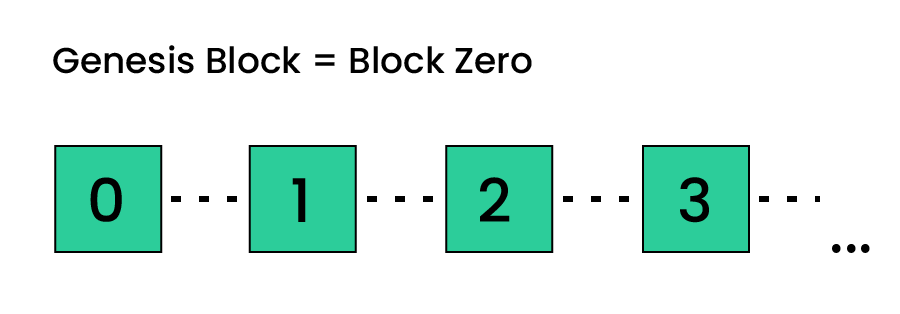What Are Genesis Blocks in Blockchain Networks



Genesis blocks are the very first blocks that establish a new blockchain protocol. The term "genesis" is derived from the Greek word "génesis," meaning "origin," "beginning," or "creation." It is perhaps most famously associated with the first book of the Bible, Genesis. There is much to learn about genesis blocks. This article will explore what a genesis block is, why it is important, and the legendary hidden message from Bitcoin creator Satoshi Nakamoto.
It is worth briefly explaining what blocks are so the role of the Genesis block becomes clearer. In a blockchain, a block is a fundamental unit that contains a list of transactions. Each block comprises several key components: a block header, a transaction list, and a cryptographic hash of the previous block. The block header contains crucial information, such as the timestamp, the difficulty level for mining, the Merkle root (which summarizes all the transactions in the block), and the nonce (a value used in mining). The cryptographic hash of the previous block links all blocks together in an immutable chain. This structure guarantees the security and integrity of the data within the blockchain, as altering any part of a block would require changing all existing blocks, which is computationally infeasible.
As mentioned above, the genesis block is simply the very first block in a blockchain network and serves as the foundation of the entire protocol. Unlike all subsequent blocks, the genesis block does not reference a previous block, making it unique. This first block is hard-coded into the blockchain's software and establishes the initial state of the network.
[.c-wr-center][.button-black]Get Started[.button-black][.c-wr-center]
From a technical perspective, the genesis block sets several critical parameters that will govern the blockchain's operation:
Beyond its technical role, the genesis block carries symbolic significance. It marks the birth of the blockchain and, by extension, the values or principles that the blockchain aims to embody. A great example might be Bitcoin; Bitcoin's genesis block contains a message criticizing the traditional banking system, reflecting Satoshi's intent to build a decentralized financial system free from governmental control.
[.c-box-wrapper][.c-box]You might be interested in: 15 Books for Blockchain Developers[.c-box][.c-box-wrapper]
The Bitcoin genesis block, known as Block 0, is the first block of the Bitcoin blockchain. It was mined by Satoshi Nakamoto, the pseudonymous creator of Bitcoin, on January 3, 2009. This block is historically notable because it marked the beginning of the cryptocurrency era that we enjoy to this day!
The height of a block refers to its position in the blockchain. Since the genesis block is the first block, its height is 0. Block 1 directly follows the genesis block. The height of the genesis block represents the origin point from which all other blocks in the blockchain are derived.

A unique characteristic of the Bitcoin genesis block is that the 50 BTC reward it generated is unspendable. This is due to a quirk in Bitcoin's code that prevents the transaction output from being spent. The exact reason for this design choice is unknown, but it is widely believed to be intentional. The first block reward serves as a symbolic gesture, signaling that the foundation of Bitcoin is not intended for personal profit but for the greater purpose of creating a decentralized financial system.
[.c-box-wrapper][.c-box]You might be interested in: What Is a Blockchain Ledger and How Does It Work?[.c-box][.c-box-wrapper]
The Bitcoin genesis block was mined by Satoshi Nakamoto, who is credited with creating Bitcoin. Although Nakamoto is the owner of the genesis block, the identity behind the name remains unknown. The mystery surrounding Nakamoto adds to the allure and mythos of Bitcoin, as the unspent 50 BTC in the genesis block remains untouched, symbolizing the creator's commitment to the project's ideals rather than personal gain.
Embedded within the Bitcoin genesis block is a now-famous message: "The Times 03/Jan/2009 Chancellor on brink of second bailout for banks." This message references a headline from The Times newspaper on the day the block was mined. Many interpret it as a critique of the traditional banking system and a statement of intent behind Bitcoin's creation—a decentralized financial system free from government intervention and unending inflation. This message has become a powerful symbol of Bitcoin's purpose and vision.
While the concept of a genesis block is consistent across all blockchains, the specific implementation and significance can vary depending on the network.
Different blockchains approach the creation of their genesis block in various ways. Some, like Bitcoin, have a genesis block that is pre-mined and hard-coded into the software. Others, like Ethereum, launched with a “fair distribution” model where the genesis block was created after a public crowd-sale (e.g., an Initial Coin Offering) of ether, Ethereum's native cryptocurrency. The goal of this approach was to achieve a more equitable distribution of tokens and reduce centralization.
In Proof of Stake networks, the genesis block usually includes an initial allocation of tokens to validators who will participate in securing the network. These are chosen based on their stake in the network, which can be seen as a way to align their interests with the health and stability of the blockchain.
[.c-box-wrapper][.c-box]You might be interested in: What Is a Nonce in Blockchain: Definition and Purpose[.c-box][.c-box-wrapper]
As discussed, the genesis block plays a big role in a blockchain's consensus mechanism. In Proof of Work blockchains like Bitcoin, the genesis block sets the initial difficulty level and serves as the starting point for all subsequent mining operations. In Proof of Stake blockchains, the genesis block might include the initial list of validators and the rules for how they are selected and rewarded.
The consensus mechanism chosen at the genesis block stage has long-lasting effects on the blockchain's scalability, security, and governance. Changes to the genesis block typically require a hard fork, which can lead to network splits and the creation of multiple versions of the blockchain.
Genesis blocks across different blockchains differ in their technical specifications and symbolic meanings.https://tatum.io/blog/blockchain-blocks
[.c-wr-center][.button-black]Start Now[.button-black][.c-wr-center]
Build blockchain apps faster with a unified framework for 60+ blockchain protocols.